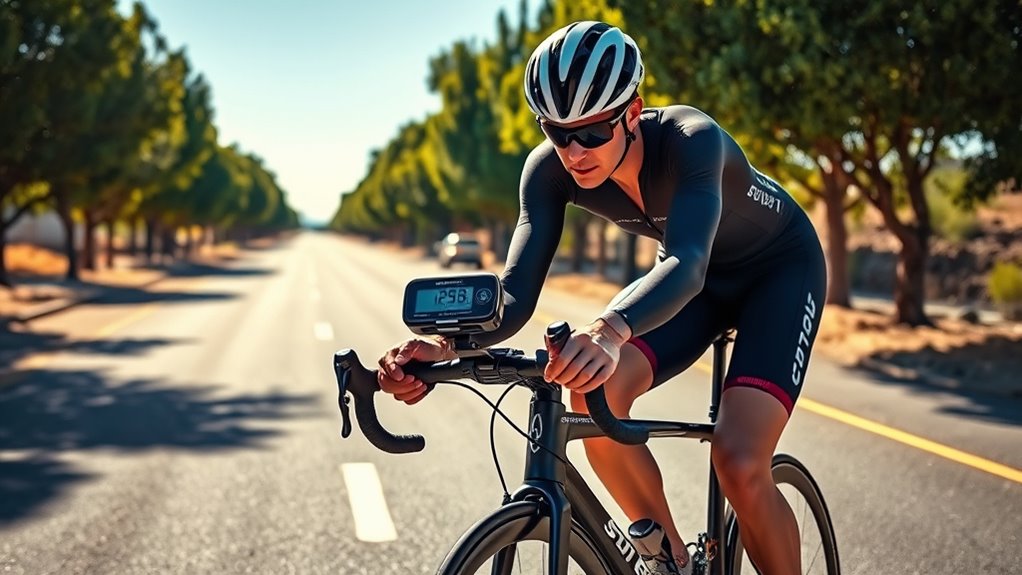To pace a time trial effectively, start by planning your effort based on the course profile and your strengths. Begin at a steady, controlled pace to conserve energy, avoiding an all-out start. Use data such as heart rate and power output to stay within sustainable limits. Adjust your effort during challenging sections and focus on maintaining momentum on flats and downhill parts. Mastering these steps helps you optimize your performance—keep going to discover more detailed strategies.
Key Takeaways
- Analyze the course profile to identify challenging segments and plan energy distribution accordingly.
- Determine your target pace or power output based on your fitness level and race goals.
- Start the race at a controlled, steady effort to conserve energy for critical moments.
- Adjust your effort dynamically during climbs, flats, and descents to optimize performance.
- Monitor your performance metrics and make real-time pacing adjustments to stay on target.

Have you ever wondered how elite athletes finish a time trial so quickly and efficiently? The secret often lies in their meticulous race strategy and exceptional energy management. When you’re racing against the clock, every second counts, and how you pace yourself can make the difference between a personal best and falling short. Proper pacing isn’t just about going hard from the start; it’s about distributing your effort intelligently to sustain high performance throughout the entire ride. To do this effectively, you need to plan your race strategy carefully, considering your strengths and the course profile. You might decide to start at a steady, controlled pace, avoiding the temptation to burn too much energy early on. This conservative approach allows you to conserve essential reserves for the final push when it counts most. Alternatively, if the course has a challenging climb or a tough section later on, you may choose to hold back slightly during the initial segments, saving energy for those critical moments. The key is to know your own limits and how to allocate your effort across the race segments. Additionally, understanding your equipment, like your projector type, can help you visualize and plan your pacing more effectively.
Energy management is at the core of successful pacing. You should aim to keep your effort within a sustainable range, avoiding the temptation to ride at maximum capacity from the outset. This means paying close attention to your perceived exertion and, if possible, monitoring your power output or heart rate. By doing so, you prevent fatigue from creeping in too early, which can cause a significant dip in performance later on. As you progress, adjust your effort based on how you feel and the terrain ahead. For example, if you’re approaching a flat section, you might slightly increase your cadence to make the most of your energy reserves. Conversely, on a downhill or winding stretch, you should focus on maintaining momentum without overexerting. Effective energy management involves a constant balance—pushing just enough to stay competitive but not so much that you exhaust yourself prematurely.
Frequently Asked Questions
How Can I Adjust My Pace During Unexpected Weather Changes?
When unexpected weather changes occur, you should adapt your strategies by adjusting your pace based on weather considerations. Slow down if it’s raining or windy to conserve energy and maintain safety. Use your awareness of conditions to modify your effort, staying flexible and responsive. These adaptive strategies help you stay on track, ensuring you complete your time trial efficiently despite weather setbacks. Always prioritize safety and comfort during unpredictable weather.
What Role Does Mental Preparation Play in Pacing a Time Trial?
Mental preparation is vital in pacing a time trial. You boost your mental focus by practicing visualization techniques, imagining yourself maintaining steady effort and overcoming challenges. This mental rehearsal helps build confidence and keeps you calm under pressure. When unexpected weather changes occur, your prepared mindset allows you to quickly adjust your pace without losing momentum. Staying mentally sharp ensures you stay on track and optimize your performance throughout the trial.
How Do I Prevent Burnout During a Long Time Trial?
Think of burnout as a wildfire threatening your race. To prevent it, stay fueled and cool with smart hydration strategies and nutritional timing. Sip water consistently, don’t wait until you’re thirsty, and fuel your body with energy-rich foods at key intervals. By tending to your body’s needs like a gardener, you keep your fire burning steadily, ensuring you finish strong instead of smoldering out.
What Are Common Pacing Mistakes Beginners Make?
You often make pacing mistakes by starting too fast, which ruins your race strategy and causes early fatigue. You might also lack pacing consistency, fluctuating your effort instead of maintaining a steady pace. To improve, focus on setting a realistic target pace from the start and sticking to it. Avoid sudden surges, and remember that a consistent effort will help you finish strong and achieve your best time.
How Should I Modify Pacing for Different Race Distances?
Did you know that marathon runners often slow down by about 10% in the last quarter? To adapt race pace for different distances, you should adjust your effort level—faster for shorter races, more sustainable for longer ones. Focus on distance adaptation by setting realistic pace targets for each race, ensuring you conserve energy for the finish. This way, you optimize performance across all race types.
Conclusion
Remember, pacing a time trial is like steering a boat through calm waters—you need steady hands and awareness of your pace. I once watched a cyclist start too fast and burn out halfway, missing out on their true potential. When you distribute your effort wisely, you’ll glide smoothly to the finish line, feeling strong and in control. Trust your strategy, stay consistent, and enjoy the ride—you’re capable of more than you think.









